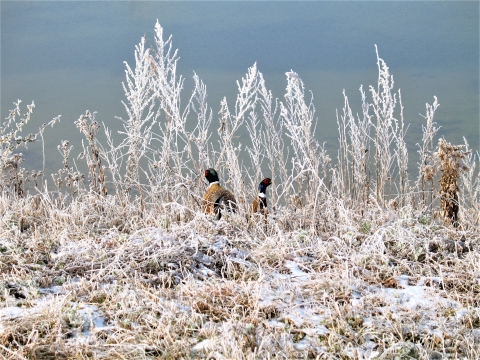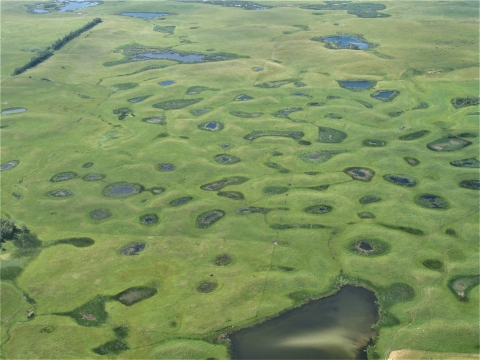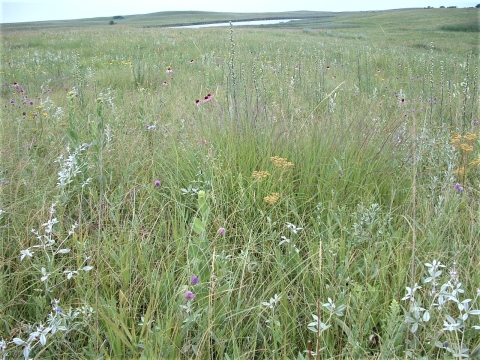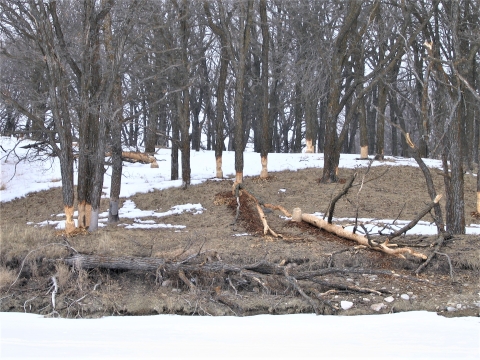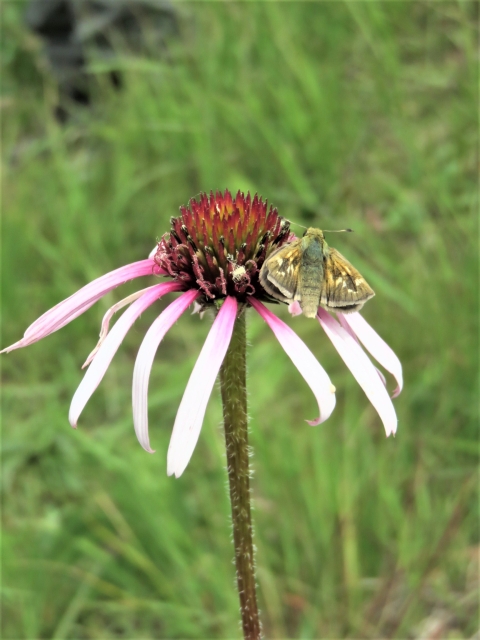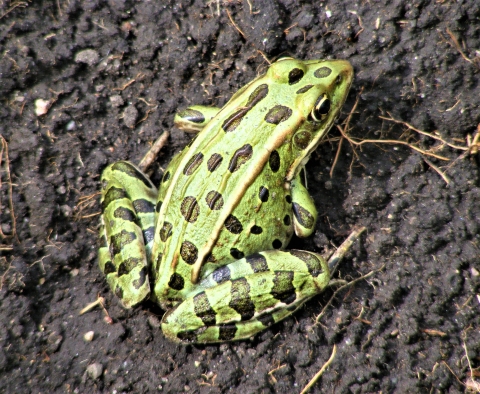Seasons of Wildlife
Wildlife
Wildlife communities have changed significantly since European settlement. At one time elk, antelope, grey wolf, black bear, otter, and marten occurred in this area. White-tailed deer were once very rare but are now quite common.
The current mix of grasslands, wetlands, woodlands, and cropland attracts a wide variety of birds, mammals, reptiles, amphibians, fish, insects, and other invertebrates.
Prairie Potholes Prairie Potholes
These freshwater marshes are found in the upper Midwestern prairies, especially the Dakotas and Minnesota. Depressions that were created by retreating glaciers about 10,000 years ago;, they fill with water during spring, providing important habitat for waterfowl and many other species. Indeed, the Prairie Pothole Region is often called America’s “duck factory” since around half of the continent’s ducks spend at least part of the year there. The prairie potholes are an important water source, and they help recharge underground aquifers.
Learn more about Prairie Potholes
Waubay Wetland Management District is located in an area of North America known as the Prairie Pothole Region (PPR). As glaciers scraped across the landscape they gouged out millions of basins which filled with water when the massive ice sheets retreated. Interspersed with grasslands, this landscape makes up only 10% of the breeding habitat in North America but produces 50% of the continent's waterfowl.
Prairie wetlands are dynamic habitats. They range in size from tiny puddles to large glacial lakes, they may be wet for a week or for many years, and vegetation can vary from tiny floating duckweed to a forest of phragmites (frag my teas). The prairie pothole wetland complexes and associated grasslands are an integral component of the prairie landscape, providing a wide array of ecological, social, and economic benefits.
Native Prairie
The Great Plains of North America once covered over a million square miles through the center of the continent. These vast grasslands were shaped under disturbances such as fire, repeated grazing, and frequent droughts. The eastern third of this prairie ecosystem, from Manitoba, to Illinois and south to Texas, is known as the tallgrass prairie region. Tallgrass prairie once stretched across almost 200 million acres, but today, less than 1% of the original tallgrass prairie remains.
The rich soils that developed over hundreds or thousands of years combined with a gently rolling topography, made the region perfect for agriculture. When John Deere patented his plow made of steel in 1865, native prairie didn’t have a chance. Within 10 years, from 1860-1870, most of the tallgrass prairie was gone.
Oak Savannas
The bur oak (Quercus macrocarpa) is one of the most widely distributed oaks in North America. They grow in a variety of habitats but tend to prefer drier and cooler sites and seem to tolerate drought conditions better than other tree species. They can live 300-400 years and grow up to 130 feet.
When fire is excluded from prairies, bur oaks can be one of the first trees to encroach on the grasslands. Indeed, once the bur oak reaches about 12 years old, it can persist easily in frequently burned areas and was once an important component of oak savannas. These savannas once covered about 32 million acres in the Midwest but only about 6400 acres of high quality oak savanna remains. Today, bur oaks are mostly found around the edges of lakes and in the coulees that form as water descends on the edges of the Coteau.
Woodlands form in the absence of fire, with basswood, green ash, and hackberry often shading out young oaks, eventually changing the composition.
Acorns, in addition to providing the next generation of oaks, are eaten by a wide variety of birds, mammals, and even insects.
Threatened & Endangered Species
There are few federally threatened or endangered animal species that are known to occur at Waubay NWR. Piping plovers have nested nearby but have not been seen in many years since high water levels have eliminated many sandy beaches around wetlands. The whooping crane will occasionally be seen migrating in this area.
The western prairie fringed orchid is the only known federally threatened plant species that may be present in this area. It occurs in moist tallgrass prairies and sedge meadows. The major reason for its decline is the conversion of native prairie habitat to cropland and tame pastures. Heavy grazing, early haying, lack of fire, and noxious weed infestations can all have detrimental effects on this orchid.
The U.S. Fish & Wildlife Service has listed the Dakota skipper as threatened and the Poweshiek skipperling as an endangered species. These enigmatic butterflies require high quality native prairie - a habitat that is disappearing and underappreciated.
Though once common over much of North America, the American burying beetle has disappeared from 90% of its range. Hypotheses explaining its decline range from deforestation, loss of available carrion in the required size since the extirpation of passenger pigeon and declines in prairie chickens, and increased competition for resources from skunks, raccoons, and other scavengers.
The bald eagle was recently removed from the endangered species list. Evidence of its success can be seen in the many nests that can be found throughout South Dakota and the country.
Sentinels of wetlands
Leopard frogs depend on clean and plentiful wetlands for survival. As part of an intricate prairie food chain, losing frogs to pesticides, excess fertilizers, wetland drainage, and climate change climate change
Climate change includes both global warming driven by human-induced emissions of greenhouse gases and the resulting large-scale shifts in weather patterns. Though there have been previous periods of climatic change, since the mid-20th century humans have had an unprecedented impact on Earth's climate system and caused change on a global scale.
Learn more about climate change might put many other species in peril.
Featured Species
Historically, the landscape of northeastern South Dakota consisted of a vast expanse of tall and mixed grass prairie with numerous shallow and deep wetlands. A rich assortment of native plants and wildlife existed, that evolved with and were maintained by fire, periodic defoliation by large herds of grazing animals, and the climate. Today the grassland habitat is fragmented, many wetlands drained, and trees planted in shelterbelts.


